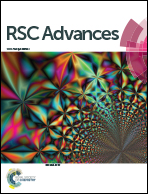Novel BODIPY dyes with electron donor variety for dye-sensitized solar cells†
Abstract
Four new donor–π–acceptor (D–π–A) structured organic sensitizers (CB1-4), with N-octyl or N-methoxyphenyl carbazole connected to a 2-cyanoacrylate BODIPY module through their 2 or 3-positions, were designed and synthesized for application in dye-sensitized solar cells (DSSCs). The photophysical and electrochemical properties were systematically studied and their performances as sensitizers in DSSCs were comparatively investigated. The structure–property relationship suggests that the electron-donating ability and substitution positions of the donor have a significant effect on these dyes' electronic and photovoltaic properties. Electron-rich N-methoxyphenyl carbazole as a donor and substitution at the 2-position shows a positive influence on the efficiency of DSSCs. Consequently, CB4, with the combination of these advantages, presents the broadest (300–650 nm) and strongest absorption profile with a high extinction coefficient (1.71 × 105 M−1 cm−1) and the best photovoltaic performance with a short circuit photocurrent density of 10.20 mA cm−2, an open circuit voltage of 600 mV, and a fill factor of 0.7, corresponding to a fairly good overall conversion efficiency of 4.28% under AM 1.5 irradiation (100 mW cm−2).



 Please wait while we load your content...
Please wait while we load your content...